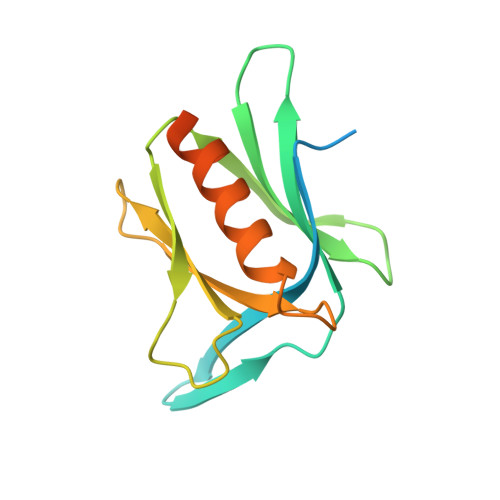Structure-guided bifunctional molecules hit a DEUBAD-lacking hRpn13 species upregulated in multiple myeloma.
Lu, X., Sabbasani, V.R., Osei-Amponsa, V., Evans, C.N., King, J.C., Tarasov, S.G., Dyba, M., Das, S., Chan, K.C., Schwieters, C.D., Choudhari, S., Fromont, C., Zhao, Y., Tran, B., Chen, X., Matsuo, H., Andresson, T., Chari, R., Swenson, R.E., Tarasova, N.I., Walters, K.J.(2021) Nat Commun 12: 7318-7318
- PubMed: 34916494
- DOI: https://doi.org/10.1038/s41467-021-27570-4
- Primary Citation of Related Structures:
7KXI - PubMed Abstract:
Proteasome substrate receptor hRpn13 is a promising anti-cancer target. By integrated in silico and biophysical screening, we identified a chemical scaffold that binds hRpn13 with non-covalent interactions that mimic the proteasome and a weak electrophile for Michael addition. hRpn13 Pru domain binds proteasomes and ubiquitin whereas its DEUBAD domain binds deubiquitinating enzyme UCHL5. NMR revealed lead compound XL5 to interdigitate into a hydrophobic pocket created by lateral movement of a Pru β-hairpin with an exposed end for Proteolysis Targeting Chimeras (PROTACs). Implementing XL5-PROTACs as chemical probes identified a DEUBAD-lacking hRpn13 species (hRpn13 Pru ) present naturally with cell type-dependent abundance. XL5-PROTACs preferentially target hRpn13 Pru , causing its ubiquitination. Gene-editing and rescue experiments established hRpn13 requirement for XL5-PROTAC-triggered apoptosis. These data establish hRpn13 as an anti-cancer target for multiple myeloma and introduce an hRpn13-targeting scaffold that can be optimized for preclinical trials against hRpn13 Pru -producing cancer types.
Organizational Affiliation:
Protein Processing Section, Center for Structural Biology, Center for Cancer Research, National Cancer Institute, National Institutes of Health, Frederick, MD, 21702, USA.















